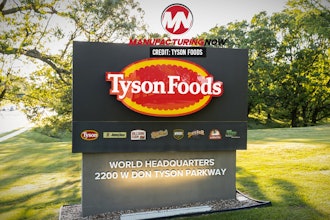
Eight major food allergens – milk, egg, peanut, tree nuts, wheat, soy, fish and crustacean shellfish – are responsible for most of the serious food allergy reactions in the United States, with sesame is an emerging concern.
For food processing factories, having a robust cross-contamination and cross contact strategy is paramount and equipment manufacturers are responding to offer smarter, more flexible ways for processors to adapt their cleaning procedures and minimize hygiene challenges at this critical point in the line, both for allergens and for food-borne pathogens.
Data confirms that the challenges around allergies in North America are real and on the rise. The number of people with food allergies in the U.S. is greater than the entire populations of New York City, Los Angeles and Chicago combined. Approximately 15 million people in the U.S. have food allergies, with the Centers for Disease Control & Prevention reporting that between 1997-1999 and 2009- 2011, food allergy prevalence among children increased by 50 percent.
While severe, life-threatening food-related allergic reactions are still relatively uncommon, studies suggest that more than 200,000 make a trip to the Emergency Room as a result of food allergies[ii]. That’s approximately someone every 2.5 minutes, and an increase of 265 percent for hospitalizations between 1997-2007, according to the Centers for Disease Control.
Is Your Machinery Sanitary?
For the food and drink supply chain, reducing the risk of consumer exposure to allergens starts with the greatest care being taken in the sourcing all ingredients, auditing suppliers, and so on. But the benefits of carefully managing allergen content can be nullified at the factory stage by cross-contamination. The risks here are especially acute given that only tiny amounts of an allergen can trigger a serious reaction in a sufferer. For this reason, larger manufacturers will, where possible, segregate production areas handling known allergens, such as nuts and seafood.
For smaller manufacturers, this option may not be available. In this case, the emphasis must fall on hygiene and good process practices. In fact, where potential allergens are present, or could be present, in some sets of ingredients but not in others, cleaning must go well beyond normal hygienic requirements. Even where heat processing is involved, allergens can still survive high temperatures.
Equipment cleaning protocols should be formalized and included in staff training. Every cleaning process needs to be verified and documented. As part of a validation process, regular tests, including swabs of Critical Control Points, should be scheduled to ensure these areas are allergen-free.
Product residues, potentially including allergens, can be especially troublesome in gravity metal detection systems for powders and particulates. This might be the case, for example, in a factory packing or processing different cereals, flours and baking mixes, where avoiding gluten content in certain products may be extremely important.
But liquids, semi-liquids and slurries in pipeline systems can pose problems of their own. Take, for example, the trend for including added dairy or soy protein, or milk content, in beverages. Dairy proteins may not be a problem where drinks are themselves milk-based, but the same filling line which handles waters and other soft drinks fortified with protein sources such as whey may also run dairy-free products.
The same issue might be true of a line filling fresh soups into pots or cartons, where recipes, including fish and seafood, alternate with others that avoid these ingredients.
Identifying the Weak Hygiene Links
Efficient product changeovers are critical to productivity. For factory managers facing regular changeovers, it is essential for processing, filling and packing lines to be designed to facilitate both quick and deep cleaning.
When it comes to specifying in-process metal detection, this means that contact surfaces on conveyor, pipeline and gravity systems should be as smooth and crevice-free as possible. This is partly to ensure that no traces of product, allergens or bacteria are left, but also to reduce the risk of cleaning agents not being fully rinsed away.
High-pressure cleaning may well be deployed for fast, effective washdown, and the casing of the metal detector should be sufficiently robust to withstand this. When selecting a system, care should be taken to identify equipment with an ingress protection (IP) rating appropriate to the washdown regime being applied.
In addition to these general criteria for the whole system, special attention should be paid to the reject unit. Ideally, this will be detachable (easily detached, but quickly and securely reattached, too) to allow thorough cleaning.
Of course, there are many other potential sources of cross-contamination in a food and drink factory. Good Manufacturing Practice (GMP) provides plenty of guidance on the hygiene and behavior of personnel. But the potential role of operators in spreading allergens by moving ingredients around the floor in unsealed containers, running allergenic products at the start of the shift rather than the end, not changing or cleaning protective equipment, for example, needs to be driven home where the risks are especially high.
Unlike labeling anomalies, which will probably show up as soon as product reaches the retailer, allergen content or harmful pathogens (just like undetected metal contamination) that haven't been notified, will usually only surface once items are on-shelf and in the hands of the consumer. At that point, product recall costs are much higher but can, in any case, be dwarfed by the massive but less immediately tangible costs of damage to the manufacturer’s brand reputation.
Developments to Curb Cross Contamination
To directly address the requirement for thorough, verifiable and efficient cleaning in factories to combat the risk of contamination, Fortress recently unveiled a new IP69K-rated and USDA compliant Meat Pump Pipeline. Especially suitable for sausage and meat patty manufacturers, as well as food factories using pastes and meat sauces in ready meals, the compact Meat Pump Pipeline Metal Detector is fitted to a mobile frame. Featuring electric powered height adjustment controlled via the HMI, the unit is quick to manoeuver around and connect to other production vacuums, and makes it easier for sanitation employees to roll out, dismantle and clean to prevent bacteria accumulations.
With no obtrusive support frame and no external boxes to accommodate electronics, and as a result of its reduced surface area and minimal use of fasteners, there are fewer places where meat residue, water ingress and bacteria can build up and potentially get embedded in pipes, nooks and crannies.
Additionally, Fortress has created a Gravity metal detector featuring a quick release retractable reject unit that can be placed on a carriage for fast removal and effective cleaning away from the line. Designed to inspect freefalling products in dry, granular and bulk form, food processing operatives can quickly disconnect, gain access to working parts, clean and slot back into place, helping to prevent high risk air borne allergens, for example nut dust, lactose or cereals containing gluten, building up in and around the Gravity unit.
Purchasing the best metal detection equipment for the job may constitute only one portion of a much bigger picture. Yet, it provides evidence that your company is taking the threat contamination from allergens and pathogens seriously and will make a real and valuable contribution to reducing those risks.
[i] https://www.foodallergy.org/sites/default/files/2018-04/FARE-Food-Allergy-Facts-Statistics.pdf
[ii] https://acaai.org/news/facts-statistics/allergies






















